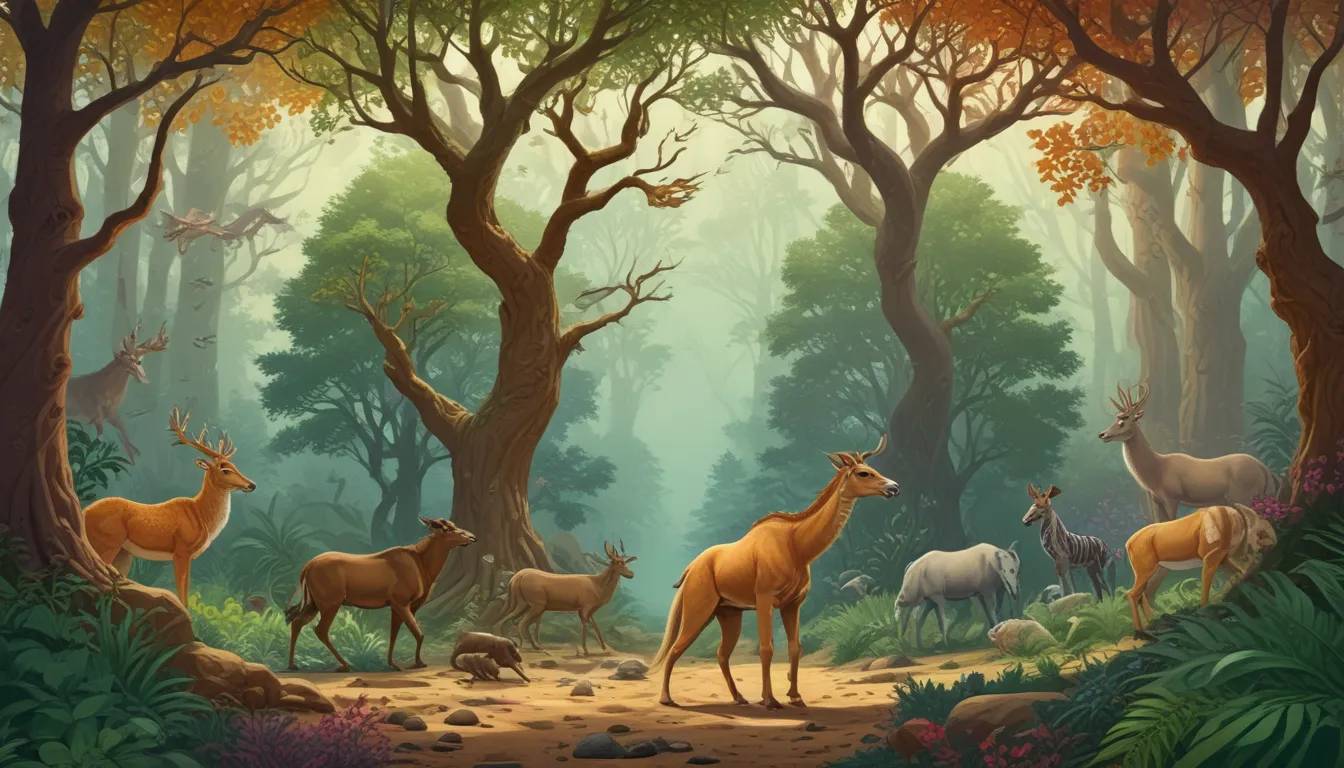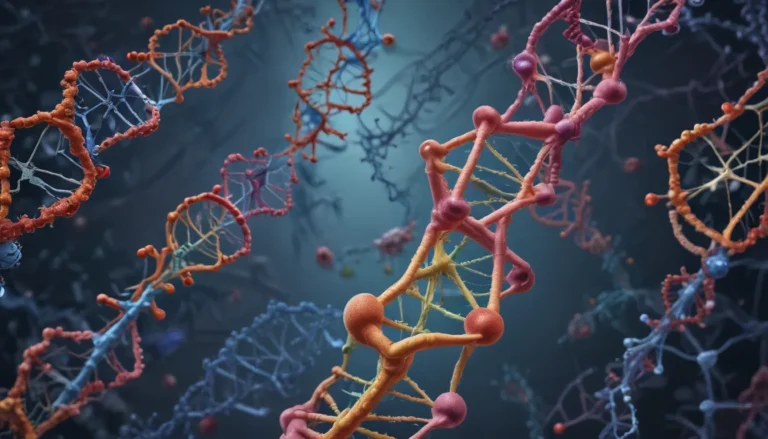A Note About Images: The images used in our articles are for illustration purposes only and may not exactly match the content. They are meant to engage readers, but the text should be relied upon for accurate information.
Welcome to the captivating world of phylogenetics, where the intricate branches of the tree of life are unravelled through the study of genetic data. In this article, we will explore 19 unbelievable facts about phylogenetics that will astound you with the complexity and diversity of life on Earth. From ancient ancestral connections to the surprising relationships between seemingly unrelated species, this exploration will expand your understanding of the natural world and the web of life that surrounds us.
Unveiling the Mysteries of Phylogenetics
Phylogenetics serves as a window into the evolutionary history of all living things, from the tiniest microbes to the largest mammals, showcasing the remarkable connections and diversity that have evolved over time. By delving into genetic data, phylogenetics not only shines a spotlight on the past but also steers medical research, conservation efforts, and advancements in agriculture, demonstrating the profound impact of this field on our world.
The Historical Tapestry of Phylogenetics
Embark on a journey through time as we unravel the rich history of phylogenetics, dating back to the 19th century. From the pioneering studies of Charles Darwin to the modern breakthroughs in DNA sequencing, the quest to comprehend the evolutionary relationships between species has been an ongoing saga of discovery. The intricate tapestry woven by phylogenetics continues to mesmerize scientists and shape our understanding of the natural world.
Illuminating the Tree of Life through Phylogenetics
At the heart of phylogenetics lies the construction of the Tree of Life, a visual representation of the evolutionary narrative of all living organisms. By scrutinizing genetic data from various species, scientists can trace their shared ancestors and unveil remarkable connections between seemingly disparate life forms. The Tree of Life serves as a guiding light, leading us through the vast tapestry of life on Earth and illuminating the processes that have sculpted the natural world.
Unlocking the Enigma of Species Origins with Phylogenetics
Delve into one of biology’s enduring mysteries: the origins of new species. Phylogenetics steps into the spotlight, offering valuable insights into the emergence of species through the analysis of genetic similarities and differences. By comparing the DNA of diverse organisms, scientists can discern patterns of speciation and gain a deeper insight into the evolution of new life forms. While the question of species origins remains a complex riddle, phylogenetics stands as a powerful tool for unraveling this enigma.
Embracing the Healing Power of Phylogenetics in Medical Research
Uncover the transformative impact of phylogenetics on medical research, where the evolutionary relationships between pathogens are scrutinized to develop more effective strategies for disease prevention and treatment. By decoding the genetic blueprints of viruses and bacteria, researchers can track the spread of infectious diseases, forecast outbreaks, and devise targeted therapies. Phylogenetic analysis emerges as a vital ally in the battle against emerging infections and the formulation of vaccines.
Nurturing Biodiversity through Phylogenetics in Conservation
At the heart of phylogenetics lies an essential role in not only unraveling the evolutionary past of species but also guiding conservation endeavors. By mapping the genetic connections between diverse populations, scientists can pinpoint genetically distinct groups and prioritize conservation efforts accordingly. This knowledge equips us to safeguard the genetic diversity within species and preserve the delicate balance of ecosystems.
Shedding Light on the Past: Phylogenetics and Ancient Lineages
Marvel at the remarkable capacity of phylogenetics to illuminate the distant past through the study of DNA extracted from fossils and ancient remains. This transformative approach enables scientists to reconstruct the evolutionary relationships of long-extinct species, offering captivating insights into the origins of life on Earth and the transformative processes that have sculpted the diversity of organisms we see today.
Unveiling the Human Story: Phylogenetics and the Study of Human Evolution
Witness the pivotal role played by phylogenetics in unraveling the mysteries of human evolution, as genetic analyses trace our lineage back to common ancestors with other primates and reveal extraordinary connections with other species. This journey not only deepens our comprehension of our evolutionary trajectory but also casts a brilliant light on our place in the intricate tapestry of the natural world.
The Evolutionary Revolution: Molecular Phylogenetics Takes Center Stage
Step into a new era as molecular phylogenetics, delving into genetic data at the molecular level, revolutionizes the field. By scrutinizing DNA sequences, scientists can craft highly accurate phylogenetic trees and resolve intricate evolutionary relationships. This branch of phylogenetics opens new horizons for research, significantly advancing our understanding of the tree of life.
Bridging Worlds: Phylogenetics and Comparative Anatomy
Experience the synergistic dance between comparative anatomy and phylogenetics, where the study of anatomical similarities and differences intertwines with genetic data. By dissecting the structures of organisms, scientists can infer evolutionary relationships and reconstruct their entwined history. This interdisciplinary fusion paints a comprehensive picture of the evolutionary connections between diverse species.
Navigating Geographic Frontiers: Phylogenetics and the World of Biogeography
Embark on a voyage where biogeography, the examination of species distribution across geographic landscapes, intertwines with phylogenetics. By unraveling the genetic relationships among diverse populations, scientists can decode the historical processes that have shaped the distribution patterns of organisms. This profound knowledge is pivotal in comprehending the forces propelling biodiversity and in crafting informed conservation decisions.
Embarking on an Odyssey of Discovery: Modern Techniques in Phylogenetics
Embark on an odyssey shaped by modern techniques and technologies that have revolutionized the field of phylogenetics. Next-generation sequencing, bioinformatics, and computational models have redefined the manner in which genetic data is analyzed and phylogenetic trees are constructed. These potent tools have accelerated research progress, unlocking new vistas in our quest to comprehend the evolutionary relationships between species.
Illuminating Extinction Patterns: Phylogenetics and the Study of Extinction
Peer into the past and present through the lens of phylogenetics, where mysteries surrounding extinction are unraveled. By analyzing the genetic connections of extinct species and their extant relatives, scientists can glean invaluable insights into the causes of past extinctions and the looming threats faced by current species. Armed with this knowledge, we can design effective conservation strategies and strive to avert future extinctions.
Embracing Challenges: The Evolutionary Journey of Phylogenetics
While celebrating its myriad breakthroughs, phylogenetics confronts an array of challenges, from complex statistical models to the rapid evolution of sequencing technologies and the deluge of genomic data. Yet, researchers persist in their pursuit of innovation, devising novel techniques to surmount these hurdles and expand the frontiers of our understanding of the tree of life.
Charting a Course to Tomorrow: The Future Horizon of Phylogenetics
Illuminate the path ahead as technology and knowledge converge to shape the promising future of phylogenetics. Anticipate even more precise and comprehensive phylogenetic trees that unveil intricate details about the evolutionary relationships between species, deepening our insight into the natural world and unraveling the processes that have molded life on Earth.
Unveiling Microbial Marvels: Phylogenetics and the Study of Microbial Evolution
Transcend the realm of macroscopic organisms and delve into the microscopic cosmos of microbial life, where phylogenetics unfurls its banner. By probing the genetic relationships between diverse strains of microorganisms, scientists decipher the mechanisms driving microbial diversity and evolution, with applications spanning fields such as medicine, agriculture, and ecology.
Safeguarding Genetic Treasures: Phylogenetics and Conservation Genetics
Witness the union of phylogenetics and genetic analysis in the realm of conservation genetics, where an intricate tapestry of insights informs conservation strategies. By scrutinizing the genetic diversity and structure of populations, scientists pinpoint crucial genetic traits and prioritize the protection of unique genetic lineages. This interdisciplinary nexus empowers us to nurture biodiversity and safeguard the evolutionary potential of species.
Cultivating Resilience: The Agricultural Impact of Phylogenetics
Explore the far-reaching implications of phylogenetics in agriculture, where an understanding of the genetic relationships between crop plants and their wild counterparts heralds the development of resilient and productive varieties. Phylogenetic analysis not only illuminates pests and diseases but also spurs the creation of robust disease resistance strategies and sustainable agricultural practices.
Navigating Ethical Waters: Delving into the Ethical Considerations of Phylogenetics
As we navigate the sea of scientific inquiry, ethical considerations surface in the realm of phylogenetics. The knowledge gleaned from phylogenetic studies casts ripples across conservation efforts, biomedical research, and our understanding of human evolution. It becomes imperative to approach these ethical quandaries with care, ensuring our actions uphold scientific integrity and foster the preservation of biodiversity.
Basking in the Beauty of Evolution: The Awe-Inspiring Tapestry of Phylogenetics
Immerse yourself in the beauty and wonder of evolution as phylogenetics unveils the interconnectedness of all living beings. From the minutest microbes to the grandest mammals, the study of phylogenetics invites us to marvel at the diversity and adaptations that have blossomed throughout evolutionary history. This journey through the marvels of phylogenetics beckons us to appreciate the intricate tapestry of life on Earth and revel in our place within it.
Embark on a Journey Through Phylogenetic Trees
As we culminate our exploration of phylogenetics, delve deeper into the mesmerizing world of phylogenetic trees. These branching diagrams serve as windows into evolutionary relationships, shedding light on the interconnectedness of all living beings. Prepare to be captivated by the beauty and complexity of the tree of life as you embark on this enthralling voyage through the marvels of phylogenetics.
FAQs: Navigating Your Phylogenetic Quest
-
What is phylogenetics?
Phylogenetics is the study of the evolutionary relationships between different species, based on their genetic makeup. -
How is phylogenetics conducted?
Phylogenetics entails the comparison of genetic sequences, such as DNA or protein sequences, through computational algorithms that construct phylogenetic trees. -
Why is phylogenetics significant?
Phylogenetics plays a pivotal role in unraveling the history and diversification of life on Earth, contributing to fields like medicine, conservation, and agriculture. -
What constitutes a phylogenetic tree?
A phylogenetic tree is a branching diagram that depicts the evolutionary relationships between different species, showcasing common ancestors and the sequence of speciation events. -
What impact does phylogenetics have on medicine?
Phylogenetics aids in comprehending the spread and evolution of pathogens, which is pivotal for developing efficacious treatments and vaccines against diseases. -
Can phylogenetics inform conservation efforts?
Indeed, phylogenetics furnishes insights into the genetic diversity and relatedness of species, guiding informed decisions about conservation priorities and the management of endangered populations.
Conclusion: Embracing the Evolutionary Odyssey
In conclusion, the realm of phylogenetics unfolds a captivating narrative that unravels the evolutionary relationships between diverse species. Through genetic sequencing and computational tools, researchers navigate the intricate paths of the evolutionary tree of life, peeling back the layers of our biological past. Phylogenetics not only bestows valuable insights into the history of life on Earth but also serves as a cornerstone for the advancement of various fields such as medicine, conservation, and agriculture. By deciphering the patterns and parallels encoded within DNA sequences, scientists forge ahead, making predictions about gene functions, formulating innovative drugs, and charting conservation strategies. The strides taken in phylogenetics have redefined our perception of biological diversity, opening new avenues for scientific exploration and deepening our understanding of the mysteries of the natural world.
Was this Journey Enlightening?
Our commitment to delivering trustworthy and engaging content remains unwavering, as we venture through the realms of phylogenetics and beyond. Each fact on our site is an offering from real users like yourself, enriching our collective understanding with an array of diverse insights and information. To ensure the highest standards of accuracy and reliability, our dedicated editors meticulously review each submission. Rest assured that the facts we share are not only captivating but also credible. Trust in our dedication to quality and authenticity as we explore and learn together on this enriching journey.






